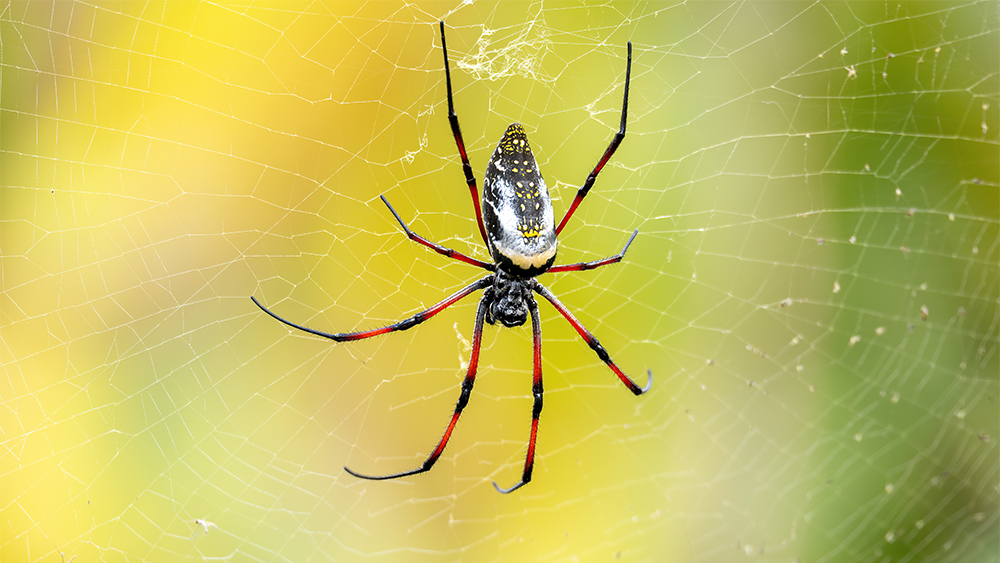Big doesn’t always mean strong. Most of the time, strength comes from what something is made of. The proteins forming spider silk make that silk one of the strongest materials in the world. Ounce for ounce, spider silk is the strongest. The golden orb-weaver spider’s webs can stop a bee mid-flight at 20mph and can even stop small birds. If humans could create spider silk as thick as a pencil, it could stop a jet airplane mid-flight!
All spider silk is incredibly strong and tensile, but the silk of the golden orb-weaver spider catches the researcher’s eye the most, not just because of its beautiful yellow sheen, but because of its properties. According to an article published by the Medical University of Vienna, “[golden orb-weaver] silk is more tear-resistant than nylon and four times more elastic than steel, is heat stable up to 250°C, extremely waterproof and, on top of that, has antibacterial properties.”1 These features, especially antibacterial properties, are making medical doctors and researchers wonder how the silk might be utilized in the medical world.
According to the Natural History Museum, golden orb-weaver spiders, part of the genus Nephila, live in various warm regions of the world, and can be found on almost every continent.2
Spiders have specialized glands that create unique web mixtures for different purposes. Across spider species, there are 7 different types of webbing.3 According to an article in the journal Nature, most spiders do not have all 7 glands; however, it is possible to find a female orb spider with all seven.4 A Smithsonian article explained, “[silk] is produced in internal glands, moving from a soluble form to a hardened from and then spun into fiber by the spinnerets on the spider’s abdomen.”5 Each kind of silk has a specific purpose and function. The silk used for a web’s frame is the strongest.
Scientists and engineers have tried to replicate spider silk for decades. But according to Dr. Brian Thomas in ICR article “The Masterful Design of Spider Webs,” man “cannot make the raw materials of silk with man-made machinery…only a spider’s silk and spinnerets can assemble the world’s most resilient biodegradable thread.”5
Man might never be able to perfectly replicate the spider silk that Jesus, the Creator of the Universe designed. Nevertheless, scientists and surgeons have found another resourceful way to use His creation. A study posted on ScienceDaily.com, conducted by Christine Radtke, a Professor for Plastic and Reconstructive Surgery at MedUni Vienna General Hospital, showed that the silk of golden orb-weaver spiders “have great potential for nerve and tissue repair.”1 In 2016, Radtke and her colleagues developed the technique. “'The nerve fibres use the silk fibres to grow along in order to reconnect with the other end of the nerve. The silk provides the cells with good adhesion, supports cell movement and encourages cell division.’”1
Ordinarily, if an interposition graft is needed for nerve fibers to grow back together, it is only successful over short distances, “4cm, at most.”1 Radtke’s study stated that by instead using golden orb-weaver silk, the following occurs:
In an animal model, this technique successfully repaired nerve damage over distances of up to 6cm: the nerve fibres grew back together in a functional way within 9 months. At the same time, the framework of spider threads, which is a natural substance, was completely broken down by the body. Equally, spider silk does not provoke a rejection reaction.1
Spider silk is currently waiting to be certified as a medical device. Once the certification is granted, clinical trials on humans can begin.1
How could a creature that is both considered a “lower life form” than humans and so much smaller than humans produce a tiny thread of silk on its own, so complex that even the most gifted engineers cannot replicate it? In ICR article “Scientists Decode Key to Spider Web Strength,” Dr. Brian Thomas wrote, “If making mere copies of spider web structure ‘requires the consideration’ of specific elements, then it stands to reason that the origin of spider web construction also required consideration.”6 Spider silk is a perfect example of creation boasting of a real Creator and of our Savior, Jesus Christ.7
References
- Medical University of Vienna. "Repairing damaged nerves, tissue, with spider threads." Posted on ScienceDaily.com July 28, 2017, accessed July 13, 2023.
- Hendry, Lisa . "What Are Spider Webs Made of? And how Do They Spin Them?" Natural History Museum. Accessed July 13, 2023.
- Babb, P., Lahens, N., Correa-Garhwal, S. et al. The Nephila clavipes genome highlights the diversity of spider silk genes and their complex expression. Nat Genet 49, 895–903 (2017). .
- Ault, Alicia. "Ask Smithsonian: How Do Spiders Make Their Webs?" Smithsonian. Posted on smithsonianmag.org December 3, 2015. accessed August 3, 2023.
- Thomas, Brian. "The Masterful Design of Spider Webs." Creation Science Update. Posted on ICR.org March 30, 2012, accessed August 3, 2023.
- Thomas, Brian. "Scientists Decode Key to Spider Web Strength." Creation Science Update. Posted on ICR.org March 19, 2012, accessed August 3, 2023.
- Job 12:7-10














